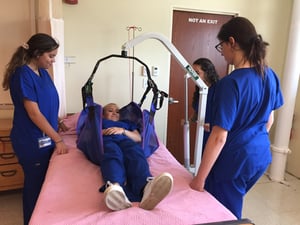Career and Technical Education (CTE) | Work-Based Learning
Work-Based Learning vs. Simulated Work-Based Learning vs. Community-Based Learning: What’s the Difference in CTE?
For nearly 10 years, Bri has focused on creating content to address the questions and concerns educators have about teaching classes, preparing students for certifications, and making the most of the iCEV curriculum system.
Career and technical education (CTE) teachers are scrambling to find ways to give students workplace experience opportunities to secure their futures (and Perkins funding).
To help you navigate the complicated world of giving students hands-on experience, we’ve created an in-depth comparison of three options available to you:
- Work-based learning
- Simulated work-based learning
- Community-based learning
In this post, we’ll discuss each option, including what they look like in a CTE program, their benefits, and the challenges they pose to educators.
Let’s get started!
What Is Work-Based Learning?

Work-based learning (WBL) is a federally-supported program in CTE that connects workplaces to classrooms to prepare students for real-world careers.
In general, students who are part of a work-based learning program spend time in the classroom and the workplace.
Every state has slight variations on how they implement work-based learning in their CTE programs. For example, Georgia’s WBL program has strict standards for what must be taught while Pennsylvania doesn’t have any standards at all.
However, because work-based programs are run by the government, all of them must meet four requirements:
- A strong emphasis on activities
- A detailed framework for implementation
- Input from local employers on the validity of the program plan
- Professional development for teachers, administrators, and others involved in the program
For more details about these requirements, check out this article: What Is Work-Based Learning?
What Does WBL Look Like?

Depending on the course and career path the student chooses, WBL opportunities can look very different.
Some common types of work-based learning include:
- Job shadowing
- Internships
- Clinical experience
- Cooperative education (Co-Op)
- Apprenticeships
In some cases, WBL is tied to a specific course, meaning all students in that course participate in the program. In other cases, WBL is specific to an individual student.
Additionally, depending on the type of work-based learning that occurs, the time involved can widely vary. A job shadowing experience could be for one or two days, while an apprenticeship could sometimes last months.
Based on these attributes, here’s a few examples of what WBL can look like for CTE students.
Job Shadowing
Depending on the scenario, job shadowing could either be a requirement for all students in a course or be specific to students with certain careers in mind.
Job shadowing could entail a student in the manufacturing cluster could spend time at a local manufacturing plant to shadow someone or even practice using equipment such as a CNC machine.
A job shadowing experience like this will typically occur over one or two days.
Depending on the program and employer, the actual time spent shadowing or learning to use equipment will vary.
Clinical & Internship Experiences
In the CTE health science career cluster, high school juniors and seniors often participate in clinicals or internships at healthcare facilities.
Clinical experience is required for health science students, so it’s usually integrated as part of a course requirement that all students must complete.
These clinical experiences sometimes run in tandem with classroom learning, meaning students spend half of the day at school and the other half in the workplace.
In other cases, clinical experiences take place towards the end of a course. In those instances, a student may only be in the classroom one day per week, with the other days spent on location.
While each of these examples are different, they can all be categorized as work-based learning, since students spend time learning in the workplace!
What Are the Benefits of WBL?

Work-based learning provides many benefits for students, schools, and employers.
Some of the biggest benefits for students include:
- Connecting and networking with professionals in the industry, potentially meeting their future employer
- Marrying what students learn in the classroom to real-world application and practice
- Giving students a better understanding of how things work in the workplace
For teachers and schools, some benefits of WBL include:
- Increased student retention rates in school
- More options for individualized student instruction
- Alternatives to building expensive labs for students to practice in
Lastly, employers involved in work-based learning programs benefit in these ways:
- Excellent potential employees
- Higher employee retention
- Lower training and recruitment costs when hiring new employees
Overall, work-based learning has these benefits and more!
However, there are some pretty big challenges that come up with work-based learning programs.
What Are the Challenges with WBL?

In general, there are three common challenges when it comes to successfully running a work-based learning program:
- Not enough clinical or shadowing opportunities available in the local community
- Students getting kicked out of the program due to unprofessional actions or lack of skills
- Potential workplace liabilities like child labor laws, especially in construction and manufacturing
Because of these challenges, many educators have begun implementing the next item on our list -- simulated work-based learning.
What Is Simulated Work-Based Learning?

Simulated work-based learning gives students the experience of traditional work-based learning, but without leaving the school.
The purpose of simulated work-based learning is to provide workplace opportunities for students unable to participate in traditional WBL.
Because simulated work-based learning is a variation of standard WBL, it has the same four requirements from the federal level.
What Does Simulated WBL Look Like?

Depending on the resources available to a CTE program, teachers can choose one of these types of simulated work-based learning models:
- Simulated tools and scenarios
- Simulated workplaces
- School-based enterprises
Here we’ll give an example of each type of simulated work-based learning strategy to show the similarities and differences.
1. Simulated Tools and Scenarios
Simulated tools and scenarios are the most common type of simulated work-based learning option. You may already be implementing them in your class without even realizing it!
From mannequins in health science classrooms to driving simulators for transportation students, it’s very common for CTE programs to use simulation tools in their classrooms.
In essence, simulation tools and scenarios are designed to mimic the look and feel of actual industry tools to give students practice with them.
What’s great about this model is that students can practice realistic and potentially high-risk scenarios in a safe classroom setting.
In addition, it could even work to have an industry professional visit your class to demonstrate the skills you’re teaching!
2. Simulated Workplaces
Simulated workplace environments take the previous model one step further.
Instead of just having tools and small scenarios, a simulated workplace is meant to make students feel as if they were truly “on the job.”
Simulated workplaces vary in how detailed and realistic they are, depending on the resources a school has.
In some cases, a simulated workplace can be a “hybrid program” that also involves simulated tools.
This is common in health science lab settings where a room may be set up like a hospital for students to work through scenarios with mannequin “patients.”
This is a great way to bridge your classroom to the workplace without sending students to a facility.
3. School-Based Enterprises
School-based enterprises are simulated work-based learning environments commonly associated with the business management and administration career cluster.
This model involves students running a business in which they purchase or create products, market the goods, manage finances, and even pay employees.
Common examples of school-based enterprises are school stores or student-run print shops.
While school-based enterprises are similar to simulated workplaces, the biggest difference is the students actually run it as a real business that generates revenue.
What Are the Benefits of Simulated WBL?

The biggest benefits of simulated work-based learning are the opposite of the pitfalls of traditional work-based learning.
Simulated WBL opens up new opportunities for schools located in areas with limited options for shadowing, clinicals, and internships.
In addition, there are fewer concerns in terms of liabilities and insurance related to worksite experiences.
Overall, students make good connections between their classroom learning and real-life context, but encounter fewer barriers that cause problems for implementation.
What Are the Challenges with Simulated WBL?

The biggest challenge with implementing simulated work-based learning is the cost.
Simulation tools and equipment can be costly, so a true simulated work-based learning environment includes a lot of red tape and funding requests.
An additional issue that occurs with simulated work-based learning is finding ways to get employers involved.
In general, employers are more likely to participate in traditional WBL programs.
With simulated WBL, you’ll need to find ways to encourage employer involvement and get them to come out to your classroom or lab.
It’s not impossible, but it can take time!
If you’re struggling to get employers involved with your CTE program, the last option on our list could be your best choice.
What Is Community-Based Learning?

Community-based learning, also referred to as service learning, is a strategy that combines CTE with community service projects.
This approach is less focused on interactions among students, employers, and workers than the previous options.
Instead, community-based learning connects your classroom to the community specific to a CTE career cluster or pathway.
What Does Community-Based Learning Look Like?

In general, there are three common types of community-based learning:
- Indirect service
- Direct service
- Advocacy
Each type of community-based learning differs in how the student interacts with the community and those they are serving.
Indirect service projects are the most common type of community-based learning.
They involve students doing “behind the scenes” work, such as collecting food donations or landscaping a local area.
Direct service projects involve students interacting with the people being served.
A class of students planning to become educators may plan story times with young children as a direct service project.
Advocacy projects are more rooted in identifying and eliminating problems in the local community.
An example of advocacy would be identifying a local health issue, coming up with a plan to address it, and proposing the plan to local policymakers.
Overall, community-based learning puts more responsibility on the students’ shoulders.
Unlike the other models where the instructor plans every aspect of the instruction, community-based learning allows the instructor to act as more of a guide.
What Are the Benefits of Community-Based Learning?

Community-based learning has three major benefits, each for a different group of people involved in the program.
First, community-based learning is an excellent choice for CTE programs that are unable to implement WBL or simulated work-based learning.
In addition, students involved in community projects are applying their knowledge and skills to real tasks, not just in simulated settings. This aspect can really cement the ties between your classroom content and what goes on outside your doors.
The last and most interesting benefit is the fact that your community becomes more connected and invested in your CTE program.
What Are the Challenges with Community-Based Learning?

Community-based learning proposes two unique challenges for CTE teachers.
Depending on the scope of the project, the time involved can become a big hurdle. This is especially problematic for a teacher who has students working on multiple projects at one time.
In addition, if a project is not successfully completed, there is a risk that the community is less invested the next time around.
Which Is Right for You and Your Students?
With all of this information about WBL, simulated WBL, and community-based learning, how are you supposed to decide what’s next?
Ultimately, only you know what would work best for your program. Here are a few points to consider when making your decision.
Work-based learning is a great option for students who need to learn hands-on skills and use specific equipment to do so.
Simulated work-based learning is a good choice for schools who don’t have access to local workplaces, but still need to give students practice with hands-on skills and equipment.
Community-based learning works well for teachers who want to tie their classroom lessons to what’s happening in the local community.
No matter which option (or options) you choose, take your time to get everything started on the right foot!
That’s why CTE teachers across the country have implemented digital curriculum as a way to support their WBL programs.
The AES digital curriculum helps teachers run successful WBL program in four specific ways:
- Keeping students on task during class time
- Reinforcing concepts and skills for success in WBL
- Keeping students on track with your syllabus
- Teaching soft skills
Want to learn more?
Click below to read the full article!


